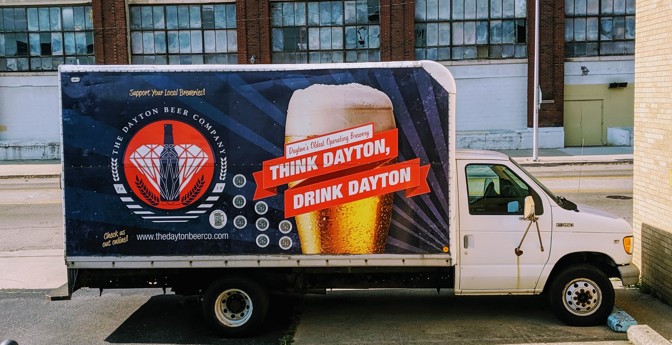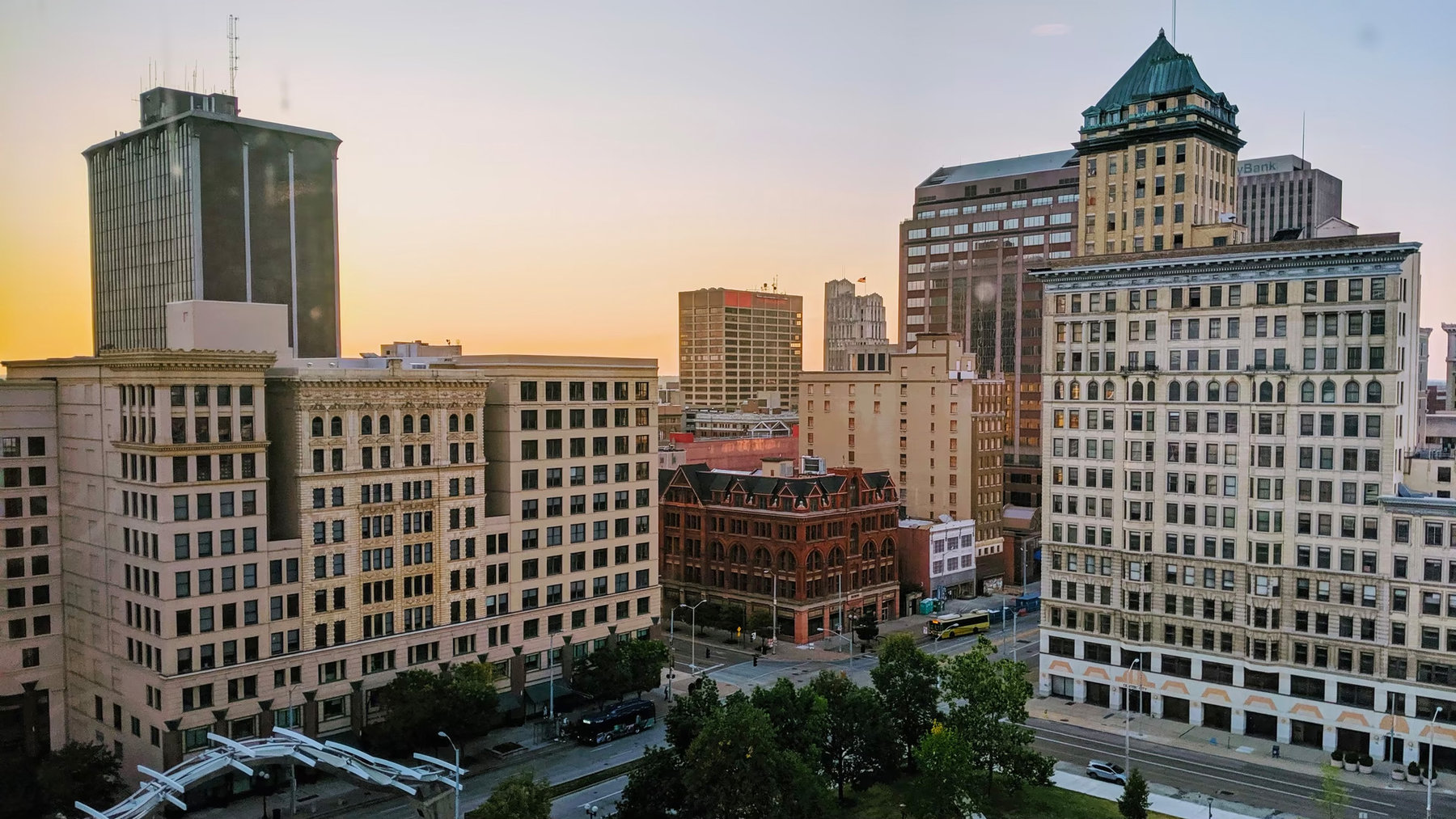Almost every trend affecting modern America is on display in Dayton. It was one of the earliest, and hardest-hit, centers of the opioid disaster. Its economy, plausibly known as America’s “invention capital” in the early 1900s, as the home of the Wright brothers and with the highest-number of U.S. patents per capita, has been hurt even more than other midwestern cities’ by the demise and departure of big firms. Last year a PBS documentary, Left Behind America, described what happened when the Dayton-born corporation NCR, plus others, left town. The excellent recent movie American Factory (Atlantic review here) portrayed the next chapter in that story, as the Chinese automotive-glass firm Fuyao reopened a closed GM plant. The city’s population has fallen significantly from its factory-era peak.
This past May, marchers from the Ku Klux Klan held a rally in town—and Klan opponents put on a bigger display. Just a few days later, a series of devastating tornados roared through the town. Then, in the first weekend of August, Dayton was of course the site of a mass shooting, a few hours after another gun massacre, in El Paso.
 A mural in the Dayton Region’s Walk of Fame, in the Wright-Dunbar neighborhood, depicting three local sons. On the left, the writer Paul Laurence Dunbar. On the right, Orville and Wilbur Wright. In the late 1800s, Dunbar and Orville Wright were friends and classmates at Dayton Central High School, where Dunbar was the only African American student and the editor of the school newspaper. (James Fallows / The Atlantic)
A mural in the Dayton Region’s Walk of Fame, in the Wright-Dunbar neighborhood, depicting three local sons. On the left, the writer Paul Laurence Dunbar. On the right, Orville and Wilbur Wright. In the late 1800s, Dunbar and Orville Wright were friends and classmates at Dayton Central High School, where Dunbar was the only African American student and the editor of the school newspaper. (James Fallows / The Atlantic)But Dayton also has a wide variety of ambitious new projects under way. It will soon open a pioneering addiction-treatment center, in partnership with the Alphabet/Google life-sciences enterprise, Verily. The Dayton Arcade structure that was once the pride of its downtown is in the middle of a $90 million renovation project, similar to ones we have seen as centerpieces of transition in cities from Greenville, South Carolina; to Allentown, Pennsylvania; to Bend, Oregon. Dayton’s public-library and arts scenes are civic assets.
The University of Dayton, a research university founded by the Catholic Marianist order and with more than 8,000 students, is opening new downtown offices and research centers. Eric Spina, an engineer who came from Syracuse to become the University of Dayton’s president three years ago, has announced a strategy of making the university “the anchor institution for the entire community,” as he put it last week at a conference in Dayton I attended called “Gem City Rising.” (Why “Gem City”? Apparently not because Dayton was ever a jewelry center. One hypothesis, relayed by the Dayton Daily News, is that some outside writer called it “the gem of all our interior [American] towns” in the 1840s.)
The city’s mayor, Nan Whaley, a Democrat who is in her early 40s, was elected to the City Commission 14 years ago, while in her 20s, and is now in her second term as mayor. Deb Fallows and I have known her and followed her career for several years. She won national attention, and based on what I’ve seen wide acclaim, for her statements and appearances after the shootings in August. The exception in the admiring chorus was Donald Trump himself. While on Air Force One, headed from Dayton to El Paso, Trump began sending tweets attacking Whaley, because he felt that in a press conference she hadn’t been effusive enough about the reception he received from shooting victims he saw in the hospital.
 Sherrod Brown, a Democratic senator from Ohio, and Dayton’s mayor, Nan Whaley, greeting Donald Trump when he arrived in Dayton in August to meet victims of the shooting there (Leah Mills / Reuters)
Sherrod Brown, a Democratic senator from Ohio, and Dayton’s mayor, Nan Whaley, greeting Donald Trump when he arrived in Dayton in August to meet victims of the shooting there (Leah Mills / Reuters)By coincidence, I was in Dayton on the August weekend of the shootings. The coincidence was aviation-related: To get back into the aerial world, I was doing flight training at Steel Aviation, based at the tiny Phillipsburg Airport just outside town, and was staying at a motel near the main Dayton International Airport. On Saturday evening, August 3, with a day’s worth of instruction behind me, I went to Dayton’s revived and thriving downtown Oregon District to walk around and, naturally, to stop in at the Dayton Beer Company to have a beer. I had just one, since I had to drive back to the motel, but I also got a to-go six-pack of their Oregon Alley IPA. (Plus, since I didn’t then know when I’d next be in town, a souvenir take-home six-pack of canned Gamma Bomb from the nearby Warped Wing brewery. )
Later that night, the Dayton mass shooter opened fire in the Oregon District. Although on-scene armed police responded within 32 seconds and killed him almost immediately, the rapid fire and large ammunition capacity of the AR-15–style rifle he brought with him allowed him to murder nine people and wound 27 others before he went down.
Within 24 hours, network- and cable-news crews were on-scene in Dayton. This was the look of the Oregon District late Sunday afternoon, less than 24 hours after the killings, with one network’s crews on one side of East Fifth Street, not far from the shooting site, and another across the street:
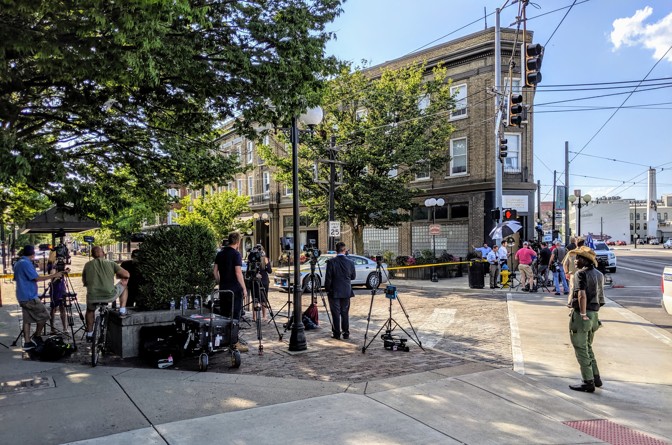
Again for aviation reasons, I was back in Dayton less than two weeks after the shootings. This time I went to Nan Whaley’s office at City Hall to ask her what it was like to be the center of cable-news attention for three or four days—and then to know that the 24/7 coverage would move on to the next breaking-news site.
“This has been a really important, special part of our community,” Whaley told me about the Oregon District when I spoke with her. The district—pronounced in the Midwest as Or-e-gone, versus the West Coast pronunciation Or-uh-gun—has a beautiful residential area and small stores, but during Dayton’s economic decline was dangerous and distressed. Now it’s the site of restaurants, locally owned stores, restored homes, and the general vibe of economic improvement you find in many midwestern downtowns.
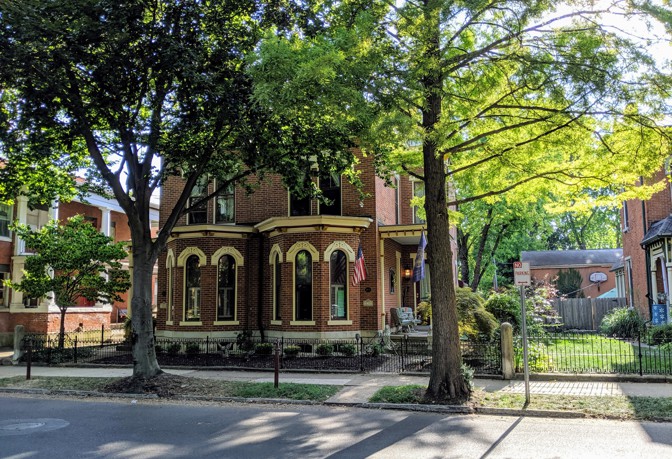
Whaley said that since the shooting, she had been in touch with the mayors and other leaders of communities that had suffered similar disasters. The diversely appealing nature of the Oregon District, she said, made this shooting different from some other recent massacres.
“I was talking with the mayor of Parkland [in Florida] about their high-school shooting and the mayor of Pittsburgh about the Tree of Life [synagogue] shooting,” she said. “Those were mass shootings at communities where people all belonged—they were going to school, or going to services.”
By contrast, she said, the crowd in downtown Dayton was a diverse group of people who all just happened to be there for a night out (as I had happened to be there, in the same space, a few hours earlier). “This is more like the Aurora, Colorado, shooting [at a theater], where by chance people were there at the same time.” The several dozen people who were killed or injured, and the hundreds exposed to the shooting, were “a super-diverse group, with very different stories, some of them not even from the state of Ohio, and all illustrating the kind of community we have now.”
“This was the place where the urban renaissance happened first in Dayton,” she said. Houses and apartments are in demand; the mix of businesses had changed from mainly bars to “the right number of bars, and restaurants and locally owned stores.” It was, she said, “a place for everybody—and in a kind of a grotesque way, the very diversity of the shooting victims showed that.” The nine people killed were black, and white; male, and female; older, and younger; from the area, and from far away. “One of them [Saeed Saleh] had grown up in Eritrea and walked across the Sahara desert—only to get here, and be killed in the Oregon District, which like all the stories was heartbreaking,” Nan Whaley said. “In a town that is still too separate and too unequal, the district represented more of what we all wanted the city to become. It’s a place for everybody.”
“My concern,” she said in August, “is that the shooting stops that work and that vitality and that uniqueness.” What comes next for Dayton will be the subject of the next set of reports.
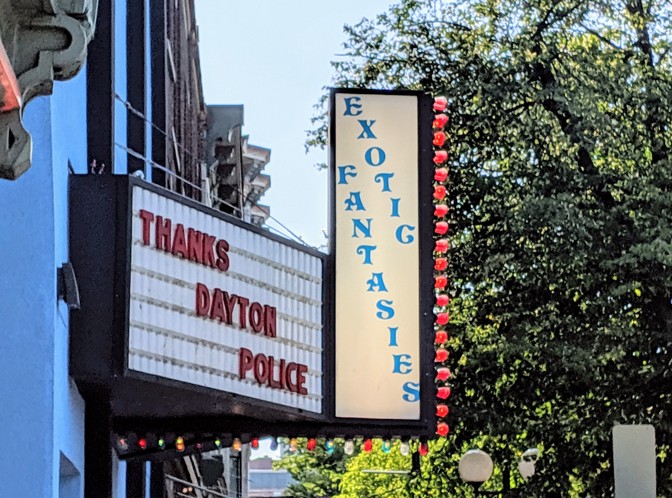
“You don’t want to be known as a city where something terrible happened,” Nan Whaley told me in August—reeling off a few other names of cities now mainly identified with gun massacres. “But you don’t want what happened here just to be forgotten.” She pointed out that just two days after the killings, Donald Trump offered condolences, in comments at the White House, to “those who perished in Toledo“—one Rust Belt city apparently being hard to tell from another. “We don’t want to be a city you can’t find on the map, or even remember the name of.”
And what did she hope would come of her city’s turn in the cable-news spotlight? “I would like us to be known as a place that action came out of,” she said this past summer.
Before the killings in Dayton, there had been 250 mass shootings in the United States in 2019. (This is defined as four people shot, apart from the shooter.) “This made us No. 251. I think every mayor whose city has suffered this way says: ‘We’d like to be the place where something happens from our pain.'” She said, back then, that she thought the traumatic effect of the Dayton shooting might have an effect at least in Ohio’s state policies.
That was the mayor’s reaction, immediately after her city’s highly publicized trauma. In upcoming installments: the longer-term efforts to revive the area’s economy, deal with addiction and related challenges, connect a divided community, and in other ways move Dayton forward.
